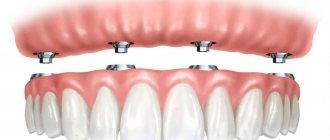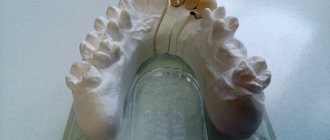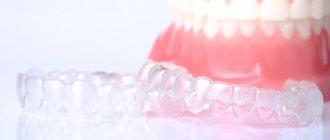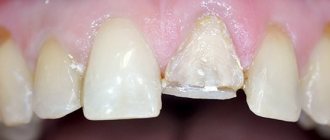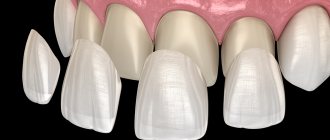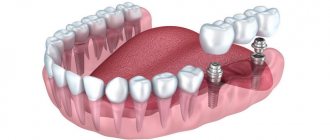Causes of structure failure
Can a dental bridge fall out immediately after installation? The reasons that a permanent dental bridge falls off after a few days, weeks (less often, months) most often lie in errors in its manufacture or fixation. But the patient’s own fault may also be present here. Let's take a closer look at the factors that cause loss in the early period:
- the use of low-quality cement or its incorrect application,
- the presence of a gap between the inside of the prosthesis and the supporting teeth on which it is placed,
- caries under crowns: this may be undetected caries - it was not noticed during preparation for prosthetics. Or when the supporting tooth was overheated during turning. If, during the passage of root canals, they are poorly processed or sealed, then over time this leads to the spread of infection,
- allergy to prosthetic materials,
- if the patient chewed something very hard with his teeth (including artificial ones), chewed toffee, toffee.
Another reason for loss is poor oral hygiene, when a large amount of plaque and stone accumulates around the crowns. This in itself can lead to the destruction of the ceramic or composite coating of the bridge and partial crumbling of the cement composition. If we consider that dental deposits are inhabited by bacteria that have a negative effect on the gums and roots of the teeth under the prosthesis, then loss can occur due to progressive caries on the supports.
A dental bridge fell out – reasons?
There are several reasons:
- The patient's diet contains sticky foods;
- Sediment has accumulated along the edges of the crown;
- The cement has lost its properties due to the expiration date;
- Habit of chewing hard objects;
- Caries develops under the crown, since pulpless teeth have reduced resistance to negative factors;
- Low teeth do not allow for high-quality fixation;
- Worn cement that does not allow for reliable fixation, then to correct the situation, gently re-fixate using a reliable composite.
- Biomechanical factor – incorrect distribution of chewing load.
Relationship between loss and service life
Dental bridges can fall out due to natural wear and tear or the end of their life. On average it is 5 years. And with good oral hygiene and careful treatment, the bridge will last up to 10 years. If the bridge is supported by implants, the service life increases. For ceramic and metal-ceramic it is at least 10 years, and for zirconium dioxide and ceramic-composite – from 20 years.
“My mother built golden bridges for herself back in the 90s. So, they stayed with her for almost 20 years. Either the doctor was such a good one, or she was taking care of her teeth. But she definitely never ate nuts. And I installed metal-ceramic ones in 2014. And they fell out after only 6 years. The doctor was able to glue them in place, but I understand that it is no longer so convenient. We'll probably have to change it."
Anastasia G., review from gidpozubam.ru
How is diagnostics carried out?
What to do if the dental bridge starts to loosen? Or if it wobbles, but only on one side? In general, if the instability of a bridge is detected, as well as before prosthetics in general, it is imperative to undergo an examination. Often the first step is X-ray diagnostics - and optimally, if this is a computed tomography (CT) scan of the jaw. Because ordinary spot and panoramic images produce a “flat picture” on one side, but CT is a three-dimensional image from all sides. Those. It is almost impossible not to notice any pathological process using tomography.
The dentist also visually and with the help of instruments assesses the condition of the oral cavity, the mobility of the prosthesis - sometimes the structure can “fly off” from the supports even during the examination. The patient is asked about associated symptoms and their duration - pain, bleeding, unpleasant odor from under the crowns, etc.
Rules of conduct when a bridge falls out
What to do if a dental bridge falls off? Often people get lost and don’t know how to behave. Someone almost begins to panic, someone hastily throws the fallen orthopedic structure into the trash. The list below includes simple and understandable rules that will tell you what to do when a dental bridge falls out:
- carefully spit everything out of your mouth onto a napkin if it falls out while eating,
- rinse your mouth with water and then with some solution (chlorhexidine or mouthwash),
- rinse the bridge in clean water, you can clean it with a soft bristle brush: when rinsing and cleaning, make sure that it does not fall into the sink or onto the floor,
- place the prosthesis in a clean handkerchief or piece of sterile bandage,
- put the bridge in a small, clean container so as not to accidentally break the product (in case it can be glued back, although this is unlikely). You will need to take the prosthesis to the clinic in the same container,
- try not to chew on the “affected” side, and also rinse your mouth after each meal (if there is still a lot of time before your visit to the clinic).
When the bridge falls out from clenching the jaws, from pressing with the tongue - that is, when there was no food in the mouth, then immediately go to point number “2” of this list.
If it suddenly turns out that the bridge was swallowed along with food or liquid, then you need to immediately contact a clinic - for example, a therapist, pediatrician, or a hospital emergency room. The sharp edges of the structure can injure the gastrointestinal tract; the bridge can get stuck in the esophagus or intestines. Therefore, you will need to undergo an x-ray or ultrasound. It is important not to make active movements, not to bend over and to adhere to the diet prescribed by the doctor - so that the structure leaves the body naturally. Otherwise, you will have to undergo emergency surgery.
In what cases should you not install a bridge?
To avoid questions about why a dental bridge is loose and what to do if it becomes mobile, you need to know about the contraindications specifically for this type of prosthesis. It is clear that if there are no outer teeth in a row or there are no more than 4 teeth in a row, then it will not be possible to install a bridge. But there are also hidden or unknown to the patient pathologies - contraindications. They can only be detected with careful preparation for treatment - we add that this is the responsibility of the dentist. But some specialists neglect diagnosis, and as a result the patient suffers.
Conditions when bridge prosthetics on natural supporting teeth are prohibited are as follows:
- atrophy or “subsidence” of the bone in the area of support: atrophy will continue further, while the gums will begin to recede, and the tooth necks and roots will be exposed. Therefore, there is a risk of inflammation or caries; the supports themselves may begin to wobble, because lose fixation in the bone,
- inflammation and bleeding of gums,
- late stages of periodontitis and periodontal disease (these pathologies are easily diagnosed): a whole range of problems is observed here - bone atrophy, inflammation and decrease in the level of gums, tooth mobility,
- “undetected” pulpitis or periodontitis in supporting units: the dentist did not remove the “dental nerve” - depulpation (although now doctors always try to do this before prosthetics),
- the presence of cysts and granulomas under the roots,
- cracks in the roots
- poor canal filling during previous treatment (and the doctor did not notice this),
- malocclusion,
- bruxism and increased tone of the masticatory muscles.
Is it possible to glue the bridge in place yourself?
What to do and how to secure a dental bridge if it falls out at home? Let us immediately point out that putting a fallen bridge back on your own is not the best idea. Since this can injure the supporting and neighboring teeth, harm the gums (if you suddenly decide to glue the bridge with pharmaceutical cement or household glue). The consequences can be unpredictable - up to the removal of “damaged” teeth or implants. Therefore, it is better to entrust your teeth to a professional dentist.
Bridge design
The main parts of a bridge are artificial teeth (sometimes simulating part of the gum) and fastening in the form of dental crowns, inlays or clasps. In appearance, all this resembles a bridge, hence the name of the prosthesis. Bridges are used to replace from 1 to 4 missing teeth in a row, depending on their type. In this case, to the right and left of the dentition defect there must be healthy teeth that can become a support for the prosthesis and withstand additional chewing pressure, which can reach several tens of kilograms.
The intermediate part of the bridge may have different principles of connection with the mucosa:
- Flushing
. When there is space between the mucous membrane and the dental bridge. A flushable bridge allows food to pass freely under the body of the structure, facilitating hygienic care.
- Tangent
. When the body of the prosthesis touches the mucous membrane on one side, which is important for the anterior area of the teeth, where it is important from a functional, speech and aesthetic point of view. A bridge of this type is usually installed on the front teeth.
- Saddle
. When the dental bridge is completely connected to the mucous membrane, joint to joint. This is not the best option in terms of functionality and reliability, but there are cases when you cannot do without it, for example, in the area of the front teeth.
What will the doctor do?
Which doctor is best to see if a dental bridge has fallen off? In general, dental prosthetics is the domain of an orthopedic dentist. If the prosthesis is on implants, then you will need to visit both an orthopedist and an implantologist, because The problem may be with the implant. Will the doctor be able to fix the old prosthesis? Here you will first need to undergo diagnostics, incl. tomography of the jaw, which will help determine the condition of the bone around the roots, the quality of root canal filling, and identify cracks in the roots.
Read on the topic: features of dental bridges - who is suitable for them, how they are made and installed.
If the support is in order and suitable for prosthetics, and the prosthesis itself has no flaws (i.e., the problem of falling out was only due to low-quality cement), then you can try to glue the old bridge in place. Of course, using new and high-quality cement.
If the doctor considers that the support needs treatment or removal, and also if the prosthesis is made incorrectly or is broken, then in addition to the main treatment, it will be necessary to make a new orthopedic bridge structure or, in principle, a different type of prosthesis.
Types of metal-ceramic “bridges”
All bridges are based either on natural teeth or on artificial roots - implants. The former are considered classical type prostheses. Constructions installed on natural teeth are much cheaper than dentures on implants. In addition, the treatment process takes place more quickly: there is no need to wait for the completion of the osseointegration process, which takes up to six months. In all other respects, an implant-supported bridge has a clear advantage. This is a more reliable, durable and aesthetic design: implants prevent bone tissue atrophy, and installation of a prosthesis does not require grinding of teeth. Read more about the method in a separate article.
What to do if a temporary bridge falls out
If the temporary bridge falls out, then there is nothing to worry about. After all, it is glued to temporary cement, which has weaker fixing properties. Therefore, you need to contact an orthopedist to glue the structure in place. Or, if a permanent prosthesis is already ready or the implants have taken root, then the temporary bridge will not be put back, but the permanent one will be fixed immediately.
Complex on 4 OSSTEM implants with delayed loading - 140,000 rubles.
Complex implantation Osstem (South Korea) with delayed loading after 4-6 months.
Doctor's work guarantee - up to 5 years (under an agreement on the provision of medical services) Call now or order a call
Opening hours: 24 hours a day - seven days a week
Prices for prosthetics
The presence of our own dental laboratory in our clinic significantly reduces the time required for prosthetics!
| Plastic crown (temporary) | PC. | 1000 rub. |
| Solid crown | PC. | 3600 rub. |
| Metal-ceramic crown | PC. | 6000 rub. |
| Metal-ceramic crown on an implant | PC. | 15,000 rub. |
| Zirconium oxide crown for implant | PC. | 16,000 rub. |
| Crown based on zirconium oxide | PC. | 13000 rub. |
| Endocrown | PC. | 12000 rub. |
| Pressed ceramic crown | PC. | 14,000 rub. |
| Stump tab | PC. | 3600 rub. |
How much does a re-restoration cost?
How much does it cost to put a dental bridge in place if it falls out? If the supports do not need to be treated or removed, then fixation with new cement will cost approximately 1000-1500 rubles. If the screws on dentures on implants have come loose, then fixing them with new screws will cost about the same. If the patient needs to treat/remove supports, install new pins or inlays - and, as a result, make a new prosthesis, then the cost of restoration starts at 30 thousand rubles. And the final cost is calculated individually.
Advantages and disadvantages
- Good functional performance.
- Aesthetics are above average.
- Low cost (except for prostheses on implants).
- Reliability and durability of the design (a classic prosthesis lasts an average of 7 - 8 years, with implant support - 15 or longer).
- The possibility of allergic reactions in the patient.
- Additional contraindications associated with the presence of metal in the prosthesis.
- Installation in the smile area is not recommended, since metal elements can shine through the ceramics; over the years, a noticeable blue line appears at the junction of the gum and the prosthesis.
What needs to be done to make the bridge last as long as possible
In order to extend the service life of the bridge, we must not forget that although it is an artificial structure, it should be treated like “natural” teeth. That is, do not load the bridges with excessively hard and stretchy food, regularly brush your teeth with a brush and toothpaste. Another important rule is that you need to visit an orthopedic dentist every 6 months. During a preventive examination, the doctor will examine the condition of the oral cavity and installed dentures, and will carry out professional removal of tartar and plaque.
1Yamamoto M. Basic technique for manufacturing metal-ceramic dentures, 1998.
Your questions and answers
QUESTION Hello, the bridge fell out of the teeth along with the pins. Can it be put back or not? And what is the best way to do this? Oksana
ANSWER Hello, Oksana. It's best not to try to glue the bridge in place yourself, because... This is fraught with complications, and consult an orthopedic dentist. Because there are many nuances due to which the old prosthesis can either be put back or not be used further (i.e., a new one can be made). But, given that your bridge fell out instead of the pins, most likely you won’t be able to put it back in place.
Author: Sambuev B. S. (Thank you for your help in writing the article and the information provided)
Conclusion
If the bridge is loose, the doctor will act in accordance with the clinical case.
If the situation allows, the depressurized structure should be removed and reinstalled with fresh cement. In more difficult conditions, it is not possible to remove the bridge without damaging it. The priority is to preserve the tooth. Therefore, a new bridge will have to be made. You should not delay your visit to the doctor, since under the shaky structure all conditions have been created for the development of pathogenic microorganisms.
To avoid loosening, it is necessary to regularly undergo preventive examinations with a doctor and follow his recommendations. Then the service life of the prosthesis will be maximum.
Author:
Mayorov Andrey Mikhailovich
Specialization:
orthopedic dentistry, dental prosthetics, implant installation
Rules for caring for bridge prostheses
Recommendations for caring for dental bridges boil down to maintaining oral hygiene twice a day. You need to brush your teeth with a regular brush and regular toothpaste, devoting morning and evening time to the procedure. Particular care must be taken when considering a dental bridge. How to clean dental bridges correctly? It is necessary not only to make circular movements, but also sweeping ones, directed from the gums to the cutting edges of the artificial teeth. In addition, be sure to rinse your mouth thoroughly, and if you have the opportunity to use an irrigator, this is an ideal option.
